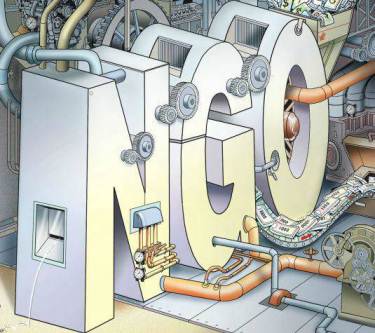Last week when Prime Minister Narendra Modi inaugurated a two-day State Environment and Forest Ministers’ Conference and made yet another ‘historic’ speech, he carefully uttered weighty words in a deep tone to express his environmental concerns. After his signature break – sip water and take deep breath – he brought his right palm near the chest, fisted the left hand in the air, and gave expression to his commitment to environment protection. To me, it seemed like an attempt (impromptu, instinctive, whatever) to camouflage something.
(While I envy Mr Modi’s mastery in engaging the mass audience with chutzpah and talk, I wonder if I can agree with the content of his speeches. When scrutinized with logic and thought, you realize that the words miss substance, the ideas lack practicability, and the ambition has no concrete roadmap – or maybe it is all there in the in-between lines and in the subtext.)
Well, coming to the point of this write-up, I merely mean to share my state of confusion about the actual stand/commitment of the Modi government on the issue of environment protection and climate change. I scanned a few recent actions of the government and leave it to you to understand what is in reserve for our environment, our forests, our biodiversity, our Earth and us.
- Blind clearances?
My doubts about the Modi-led government’s intent began in January when Environment and Forests Minister Prakash Javadekar bragged about handing out 650 green clearances within seven months of the new government coming to power. ‘We are giving clearances without even looking at the faces of the project promoters,’ the minister had said in a TV interview.
Simple mathematics says that on an average the minister cleared three projects a day, which means he might not have looked at their files either. The minister backed his bragging with a one-line assurance that ‘at least three trees will be planted for every tree that is cut.’

I wonder how his three new trees in whichever land will compensate for the destroyed natural forests, the devastated biodiversity and the displaced tribal communities… Many of you would have heard about the single-window ‘online’ clearance system launched last year. The government has boasted enough about its being capable of processing requests on the same single day. To me, it sounds more like some magic software that can access the environmental complications of a faraway land by merely reading the virtual files. (During an interaction with a senior official at one of the country’s largest steel companies, I was puzzled by the information that many such clearance applications or ‘we are compliant’ files are prepared by their chartered accountants, company secretaries or legal consultants.)
- A gift for Mamata
In early March, when West Bengal’s chief minister Mamata Bannerjee got a gift of 43 coal, power, oil and steel projects with environmental clearances and permission for diversion of forestlands, the government almost made it clear that environment, etc., could be dealt with later. Were they all on hold for mere political reasons? I doubt.
- TSR Committee report
The worst, as them pessimists warn, was yet to come.
The government-appointed TSR Subramanian Committee released its report in the last week of March. Researched, assessed, analyzed, written, printed and bound in less than three months, the report told us that key environment laws of the country needed revision. It subtly proposed that companies self-certify on ‘good faith’. Further, companies could themselves report on the effluents they discharged. The report also proposed to dilute the powers of National Green Tribunal (NGT) and insisted that only Supreme Court may take appeals.

‘In its 113-page report, TSR Committee’s recommendations are seemingly oriented towards promoting unprecedented access to land, water and other natural resources to large corporate bodies and to pave the way for mega infrastructure, industrial and urban projects,’ say environmentalist group Legal Initiative for Forests and Environment (LIFE) and EIA Resource and Response Centre. A critique titled A Recipe for Climate Disaster and Silencing People’s Voice (by environment lawyer Ritwick Dutta and activists Himanshu Thakkar and Manoj Mishra and Debi Goenka) says that the Subramanian Committee ignored larger concerns, with the phrase ‘climate change’ occurring just once in the report. The critique notes that recommendations of the committee suggest dispensing with public hearings in projects of ‘strategic’ and ‘national importance’, and dispensing with public hearings in most regions that are already severely polluted. This is based on the theory that there is no need to hear the affected public since the situation cannot possibly get worse.
Although Subramanian was not mandated to review the Forest Rights Act, his panel has suggested an amendment to theActto provide a clear exception for all linear projects relating to roads, pipelines and power lines, etc.
Last but never the least, the committee has called for suggestions from stakeholders but set a limit of 1,000 characters (not words).
- Budget cuts
Many of you are aware that Finance Minister Arun Jaitley has cut the budget allocation for the ministry of environment, forests and climate change by almost 25 per cent for financial year 2015″16. This means the ministry will fall short of Rs 1,681.60 crore and will certainly have to compromise on its projects. We have not heard of any of the ministry’s programmes having met its targets/objectives/aims, so from which projects will the ministry pull its finance plugs is a matter of wait-and-watch.
The worst affected so far has been the Integrated Development of Wildlife Habitat (IDWH) scheme, under which the country’s 600-odd national parks and sanctuaries – all except tiger reserves – and 16 endangered species are looked after. As the ministry’s budget stands slashed, the already meagre allocation for IDWH has dipped to a measly Rs 61.5 crore.
 Earlier, Rs 800 crore was earmarked for IDWH under the 11th Plan, but less than half of that amount was released during the Plan period. The ministry had demanded a fourfold hike under the 12th Plan but was turned down.
Earlier, Rs 800 crore was earmarked for IDWH under the 11th Plan, but less than half of that amount was released during the Plan period. The ministry had demanded a fourfold hike under the 12th Plan but was turned down.
Last year, the government had announced the creation of a National Adaptation Fund to tackle the effects of climate change on agriculture as well as a National Centre for Himalayan Studies in Uttarakhand to work for the conservation of the Himalayas. Both are still works in progress and Jaitley’s budget does not have anything for these.
The budget fails to allocate funds for a Himalayan Climate Change Institute that was promised by Modi in response to the catastrophic Uttarakhand floods of 2013, which left at least 4,000 tourists, pilgrims and local people dead in their wake.
Yes, Jaitley increased the clean energy cess from Rs 100 to Rs 200 per metric tonne of coal, etc., to finance clean environment initiatives. However, should you believe that Rs 200 can undo the environmental harm caused by extraction of a metric tonne of coal? Moreover, this hike will basically be funded by the public as the increased cess will make coal expensive and that will show in your electricity bills.
Jaitley announced an increase in the target for renewable energy-generating capacities, but reduced the funding for the ministry of new and renewable energy by Rs 300 crore, which is more than a two-third of its total budget. This will directly affect the country’s ‘going solar’ and ‘power through wind’ plans.
Although the tax on diesel was increased, the proposed tax on highly polluting sports utility vehicles (SUVs) was ignored. If our prime minister really believes that climate change is the fallout of our lifestyles, his finance minister could have taken at least a half step towards taxing polluting lifestyle products.
As for civil society
While a chocolate brand was grinning when Modi mentioned the term ‘five star’, it did not go down well with civil society. Although Modi did not really explain what he meant by ‘five star’, I assumed his reference was to those whistleblowing organizations that did not hesitate in filing Right to Information (RTI) applications and public interest litigations(PIL). Alternately, did he mean those groups of nature lovers who questioned infrastructural developments on forestlands, told us about the pollution in our rivers, and stood by our tribal folks? Or was he only pointing out the ones who pointed fingers at India’s social ills?
If you look at the baton that has fallen on many non-government organizations in the form of an Intelligence Bureau report, it may seem that the development sector has witnessed a major setback. Activists are now conscious and think before they raise their voice. NGOs have been reported by the IB for a range of activities – violation of the Foreign Contribution Regulation Act (FCRA), links with Left-wing extremists (LWE), conversion of tribals to Christianity, association with organizations such as Students Islamic Movement of India and Jamaat-e-Islami Hind, etc. Certifications of many organizations have been cancelled. Interestingly, when I tried to locate the names of some of these organizations under the scanner, I found that most of them were foreign-funded and had at times underlined awkward realities about public policy. The IB report clearly mentions that these organizations have held/supported/influenced protests against a range of projects including those of Posco and Vedanta in Odisha, the nuclear power plant in Kudankulam and hydro-electric plants in Arunachal Pradesh.
Some organizations are crying foul and claim to have all records in place. Some may even move court, but whether they will be able to service that battle with stalled funding is another story.


